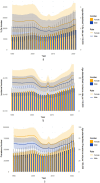The incidence, prevalence, and health burden of forearm fractures in China from 1992 to 2021 and forecasts for 2036
- PMID: 40630412
- PMCID: PMC12235915
- DOI: 10.3389/fpubh.2025.1566421
The incidence, prevalence, and health burden of forearm fractures in China from 1992 to 2021 and forecasts for 2036
Abstract
Background: Forearm fractures (Fracture of radius and/or ulna) are common worldwide and constitute a significant public-health burden. There is limited epidemiological data on radius and/or ulna fractures in the Chinese population. Using data from the Global Burden of Disease (GBD) 2021 study, this research reports the epidemiology and disease burden of forearm fractures in China, as well as projected trends for the next 15 years.
Methods: Data on the incidence, prevalence, and years lived with disability (YLDs) for Fractures of the radius and ulna in mainland China from 1992 to 2021 were obtained from the 2021 GBD database. Joinpoint regression analysis was used to analyze epidemiological trends in incidence, prevalence, and age-standardized rates (ASIR, ASPR, ASYR) over the period from 1992 to 2021. The Bayesian Age-Period-Cohort (BAPC) model was employed to project trends in incidence and YLDs for radius and/or ulna fractures in mainland China from 2022 to 2036.
Results: In 2021, there were 5,790,636 radius and/or ulna fractures in China, with 2,724,178 in males and 3,066,459 in females. The age-standardized incidence rate (ASIR) for radius and/or ulna fractures was 404.52 per 100,000, with 375.83 in males and 430.87 in females. The age-standardized years of disability (ASYR) was 2.55 years per 100,000, with 2.22 years in males and 2.82 years in females. From 1990 to 2021, both the ASIR and ASYR increased, with an average annual percent change (EAPC) of 0.09. The incidence of radius and/or ulna fractures peaked in males at ages 30-34, and in females at ages 50-54 and 65-69. Joinpoint regression analysis revealed a decline in incidence and prevalence from 2001 to 2005, followed by a significant increase from 2011 to 2021. Projected data suggests that the ASIR for radius and/or ulna fractures in males will rise from 369 per 100,000 to 374 per 100,000 from 2022 to 2029. This will be followed by a slight decline from 373 per 100,000 in 2030 to 368 per 100,000 in 2036, while the rate in females is expected to steadily increase from 427 per 100,000 in 2022 to 502 per 100,000 in 2036.
Conclusion: In 2021, an estimated 5,790,636 radius and/or ulna fractures occurred in China. Prevalence and disability rates were higher among women than among men. After a decline between 2001 and 2005, the incidence, prevalence, and disability burden of these fractures rose sharply from 2011 to 2021. Projections indicate that incidence in men will fall slightly after 2030, whereas it will continue to rise in women. These findings provide critical evidence for shaping public-health policy, designing fracture-prevention programmes, and allocating healthcare resources in China.
Keywords: China; GBD; forearm fractures; incidence; prevalence; years lived with disability.
Copyright © 2025 Zeng, Hu, Zhang, Chen, Luan, Wu and Zheng.
Conflict of interest statement
The authors declare that the research was conducted in the absence of any commercial or financial relationships that could be construed as a potential conflict of interest.
Figures




Similar articles
-
The global burden of fractures and its underlying etiologies: results from and further analysis of the Global Burden of Disease Study 2021.Arch Osteoporos. 2025 Aug 6;20(1):111. doi: 10.1007/s11657-025-01596-3. Arch Osteoporos. 2025. PMID: 40764873
-
Burden of knee osteoarthritis in China and globally: 1990-2045.BMC Musculoskelet Disord. 2025 Jul 1;26(1):582. doi: 10.1186/s12891-025-08858-8. BMC Musculoskelet Disord. 2025. PMID: 40598022 Free PMC article.
-
Analysis of trends in the burden of colorectal cancer in China and globally from 1990 to 2021 with projections for the next 15 years: a cross-sectional study based on the GBD database.Front Public Health. 2025 May 26;13:1518536. doi: 10.3389/fpubh.2025.1518536. eCollection 2025. Front Public Health. 2025. PMID: 40492005 Free PMC article.
-
National and subnational burden of brain and central nervous system cancers in China and global from 1990 to 2021: results from the global burden of disease study 2021.Arch Public Health. 2025 Jul 28;83(1):195. doi: 10.1186/s13690-025-01683-4. Arch Public Health. 2025. PMID: 40722045 Free PMC article.
-
The Black Book of Psychotropic Dosing and Monitoring.Psychopharmacol Bull. 2024 Jul 8;54(3):8-59. Psychopharmacol Bull. 2024. PMID: 38993656 Free PMC article. Review.
References
-
- GBD 2019 Fracture Collaborators . Global, regional, and national burden of bone fractures in 204 countries and territories, 1990–2019: a systematic analysis from the global burden of disease study 2019. Lancet Healthy Longev. (2021) 2:e580–92. doi: 10.1016/S2666-7568(21)00172-0, PMID: - DOI - PMC - PubMed
-
- Hoveidaei AH, Nakhostin-Ansari A, Namdari S, Hosseini-Asl SH, Khonji MS, Selk-Ghaffari M, et al. Increasing burden of upper-extremity fractures in the Middle East and North Africa (MENA): a 30-year analysis of the epidemiology and causes of injuries. J Bone Joint Surg Am. (2024) 106:323–36. doi: 10.2106/JBJS.23.00262, PMID: - DOI - PubMed
MeSH terms
LinkOut - more resources
Full Text Sources
Medical

